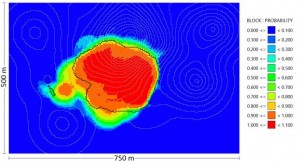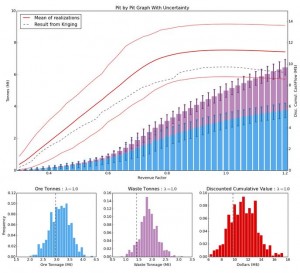Risk Qualified Decisions with Vulcan 9.1 Pit Optimiser
Earlier this week, I had the opportunity to attend the annual Society for Mining, Metallurgy, and Exploration (SME) conference in Denver. The conference was well attended, over 7,000 people, and I was able to see a lot of excellent technical talks on reconciliation, stochastic mine planning, geostatistics, and a myriad of other topics. It was a great opportunity to keep abreast with the latest and greatest advances in the mining industry and to see how mining professionals are tackling today’s challenges and bringing about the elusive mine of the future.
On Tuesday, I was fortunate enough to present a paper that Eric Gonzalez, Mike Williams, and I wrote on using simulation to make better decisions for long range planning and investors. In today’s mining industry, often it seems that the only thing that can be said with certainty is that there is uncertainty. As engineers, geologists, and investors, we know that we don’t know the future and we may not even know everything about the present. Commodity prices are ever-changing due to uncertain global markets, unpredictable costs, and disruptive technologies. Also, the extent and quality of any given deposit cannot be known completely before consequential decisions must be made. Handling these sources of uncertainty and making decisions with imperfect knowledge is a huge challenge today. Our paper proposes a workflow for explicitly analysing geologic, geotechnical, and economic uncertainty as it affects the ultimate pit in order to better understand the risks associated with any given mining project and allows practitioners and investors to make risk qualified decisions.
We used the existing geostatistical tools in Vulcan to generate a simulated geologic model. Vulcan offers both indicator and continuous simulation techniques which can be used in tandem to quantify uncertainty in geologic domains and attributes. There are options and workflows available to assess variogram reproduction, data reproduction, and histogram reproduction, which makes validating simulation results easy. Then, using the vastly improved Vulcan 9.1 pit optimizer with a simple script, we carried out an extensive Monte Carlo simulation which varied economic, geotechnical, and geologic parameters to assess uncertainty in the ultimate pit limits. We calculated full long range schedules using multiple pit analysis requiring the calculation of 23,000 optimal pits. This was performed on a block model with just over 1.7 million blocks and completed in under nine hours.
The results from the simulation study were then synthesized into maps and distributions which can be used to make better decisions. A probability block model can be calculated which shows the likelihood that any given block will be extracted. The intersection of the probability model with the surface is shown below. The pit crest from a conventional estimation-based workflow is shown as the thick black line. This clearly indicates the potential downsides from ignoring uncertainty. The single pit crest does not indicate what could happen. This model is very valuable for determining infrastructure placement and even deciding on future drilling activities.

The pit by pit graph can also be vastly improved using simulation. Error bars can be added to the ore and waste tonnes. The discounted value is also bracketed by p10 and p90 intervals. This graph is much more telling than the conventional results from estimation. Mining engineers and investors can make decisions based on the entire range of possibilities.

Performing this analysis is made easy and efficient with the latest tools in Vulcan. Analysing uncertainty is an effective way to make better decisions in today’s market. Don’t hesitate to contact your local Maptek office for more information or training/consulting to bring the latest Vulcan solutions to your deposit and make risk-qualified decisions.




